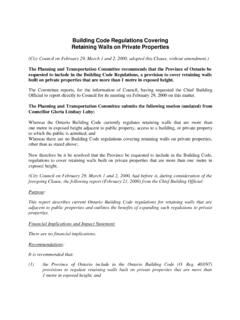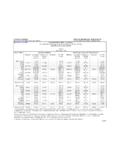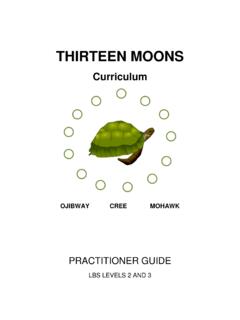Transcription of BIRD-FRIE Best PracticesGlass - Toronto
1 BIRD-FRIE . Best Practices Glass The City of Toronto would like to thank the following for their assistance in developing the bird - friendly Best Practices Glass: John Robert Carley, Architect Incorporated Fatal Light Awareness Program (FLAP Canada). Daniel Klem Jr., Professor, Department of Biology Muhlenberg College, Allentown, Pennsylvania Alison Lapp Bailey Bradshaw Hannah del Rosario Joseph Hong Photographs and artwork used with permission. Illustrations and photographs provided by: Gabriel Guillen; John Robert Carley, Architect Incorporated;. Fatal Light Awareness Program (FLAP Canada); Barry Kent MacKay;. Alison Lapp; Hannah del Rosario; Daniel Woolfson; Tim Hoeflich.
2 Karen Jiang; Alan Filipuzzi, Carol L. Edwards Front cover: Toronto waterfront illustration by Monika Hoxha bird Layout by FLAP Canada Copyright July 2016, City of Toronto Published by: City of Toronto , City Planning 2 bird - friendly Best Practices Glass The goal of this document is to inspire, suggest, and direct designers towards treatments of glass to render it as bird - friendly as possible to mitigate and prevent deaths of birds. Photo: Deadfall - Mark Thiessen, National Geographic Photographer bird - friendly Best Practices Glass 3. Table of Contents 08 What is the Problem? Dead Birds 24 Building Envelope 09 Leadership in bird - friendly Design Design to Eliminate Fly-Through Conditions 10 Why a Best Practices Manual?
3 25 Awnings and Overhangs 11 ontario Legal Context Exterior Screens, Grilles, Shutters and Sunshades 26 Creating Visual Markers The Cause: Light and Glass 29 Opaque and Translucent Glass 14 Light and Glass UV Glass (or similar products). 15 Why is the Problem Getting Worse? Low Reflectance Glass 30 Ineffective Strategies The Problem: Glass 18 Properties of Glass 19 Building Features that Impact bird Collisions 34 Toronto Green Standard 37 Compliance Strategies (TGS Tier 1). 4 bird - friendly Best Practices Glass We have the opportunity to construct well-designed buildings that are also Ryerson Student Learning Centre Picasso Condominium The glass exterior of the Ryerson University Student Centre incorporates The exterior envelope of the Picasso Condominium Building is only 43 percent strong visual markers, making it bird - friendly .
4 Glazing as compared to the typical condominium in Toronto which may include upwards of 70 percent glass. The building's facade was designed to Design by: Zeidler Partnership Architects and Sn hetta achieve higher levels of energy performance by reducing the area of exterior Photo: Lorne Bridgman glazing, with the co-benefit of a significantly more bird - friendly design. Design by: Teeple Architects Inc. Rendering by: Teeple Architects Inc. bird - friendly Best Practices Glass 5. northern ( Yellow-shafted) Flicker Photo: Mark Peck 6 bird - friendly Best Practices Glass Introduction northern Flicker from Common Birds of Toronto Drawing by Barry Kent MacKay bird - friendly Best Practices Glass 7.
5 What Is The Problem? Dead Birds Recent estimates suggest that about 25 million birds die each year from window collisions in Canada. A disproportionately high number of these fatalities occur in Toronto due to its location adjacent to Lake ontario ;. at the confluence of the Atlantic and Mississippi Migratory Flyways, and to the fact that it contains one-third of all tall buildings in Canada. bird mortality is disproportionately higher at mid-rise and high-rise buildings, which are concentrated in urban areas such as Toronto . Despite the extreme scale of the problem, there are solutions available today that can reduce bird mortality without sacrificing architectural standards.
6 North American Migratory Flyways. A dead Common Yellowthroat. Image: City of Toronto Photo: FLAP Canada 8 bird - friendly Best Practices Glass Leadership in bird - friendly Design Council Action - 2005. As a result of citizen scientists and the Fatal Light Awareness Program (FLAP Canada) drawing attention to this issue, in April 2005, Toronto City Council adopted Motion J(17) regarding the Prevention of Needless Deaths of Thousands of Migratory Birds in the City of Toronto . This led to the development of the bird - friendly Development Guidelines (the Guidelines), which was released in 2007. City of Toronto Green Development Standard bird - friendly Development Guidelines - 2007 March 2007.
7 Toronto 's 2007 bird - friendly Development Guidelines was the first bird - friendly . Council-adopted document of its kind in North America. The award winning Guidelines provided several strategies and options for making new and DEVELOPMENT. existing buildings less of a threat to migratory birds, with a focus on the two key issues that are of critical importance making glass less dangerous to GUIDELINES. birds and mitigating light pollution. These strategies could be voluntarily incorporated into the design of new buildings and into retrofit projects of Toronto existing buildings by developers and owners respectively. is the first municipality Toronto Green Standard - 2010 to require In 2010, the Toronto Green Standard (TGS) came into effect for new bird - friendly development in Toronto .
8 The TGS established performance measures for standards. green development based on local environmental drivers. Performance measures for reducing bird collisions were incorporated into the TGS, thereby Toronto Green Standard defining a green building in Toronto as one that must also be bird - friendly . Making a Sustainable City Happen The bird - friendly standards contained in the TGS have been refined from the 2007 Guidelines to include those that can be implemented through the planning approval process in the Province of ontario . Toronto demonstrated For leadership and innovation by being the first municipality in North America to New Low-Rise Residential Development (5 dwelling units or more).
9 Require new development to incorporate bird - friendly standards. Version January 2014. In 2014, the TGS was revised after substantial consultation with the public, architects, planners, designers and the development industry. The consultation process identified the standards for bird - friendly design as the most challenging for the development industry to implement. As a result, the Images: City of Toronto standards were revised. Some were altered, some were amplified, and some were discarded all in the best interest of mitigation and, ultimately, prevention of bird fatalities from striking buildings. bird - friendly Best Practices Glass 9. Why A Best Practices Manual?
10 Since the publication of the bird - friendly Development Guidelines in Best Practices' answers many of the most common questions on 2007, great advances have been made in the understanding of bird bird - friendly design and provides local examples of strategies used collisions and bird mortality from collisions with buildings. This is a to reduce the number of birds that die each year in Toronto . topic of ongoing research by the scientific community working in this area, and resulting policy development by municipalities in Canada and This document is intended to assist with the understanding of the issues the United States. The Best Practices for bird - friendly Glass has been and the implementation of the Toronto Green Standard.












